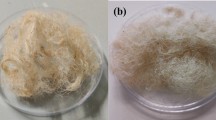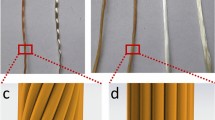Abstract
RECENT advances in the chemistry of wool and wool textile processes have been based on the simple view that the fibre consists of peptide chains bridged by cystine and salt linkages. The differences between the constituent phases of the fibre and its cells were reserved for investigation until the significance of main structural features had been determined. In connexion with a detailed study of the reactivity of the sulphur linkage in animal fibres1, however, we have found it necessary to determine whether the intercellular phase of the fibre differs in sulphur content from the cortical and cuticular cells.
This is a preview of subscription content, access via your institution
Access options
Subscribe to this journal
Receive 51 print issues and online access
$199.00 per year
only $3.90 per issue
Buy this article
- Purchase on Springer Link
- Instant access to full article PDF
Prices may be subject to local taxes which are calculated during checkout
Similar content being viewed by others
Author information
Authors and Affiliations
Rights and permissions
About this article
Cite this article
SPEAKMAN, J., MCMAHON, P. Sulphur Content of the Intercellular Phase of the Wool Fibre. Nature 141, 118–119 (1938). https://doi.org/10.1038/141118a0
Published:
Issue Date:
DOI: https://doi.org/10.1038/141118a0
This article is cited by
-
Structure of Heavy Elementary Particles
Nature (1938)
Comments
By submitting a comment you agree to abide by our Terms and Community Guidelines. If you find something abusive or that does not comply with our terms or guidelines please flag it as inappropriate.



